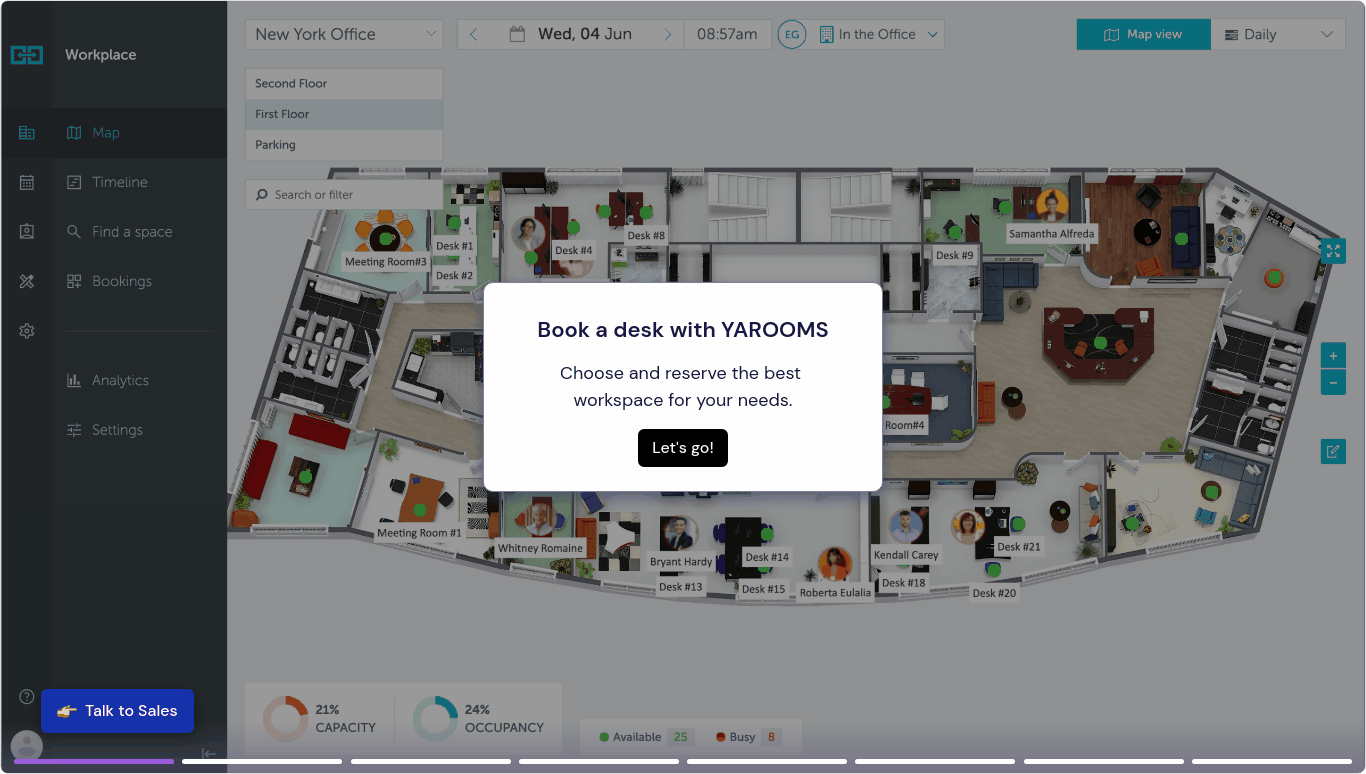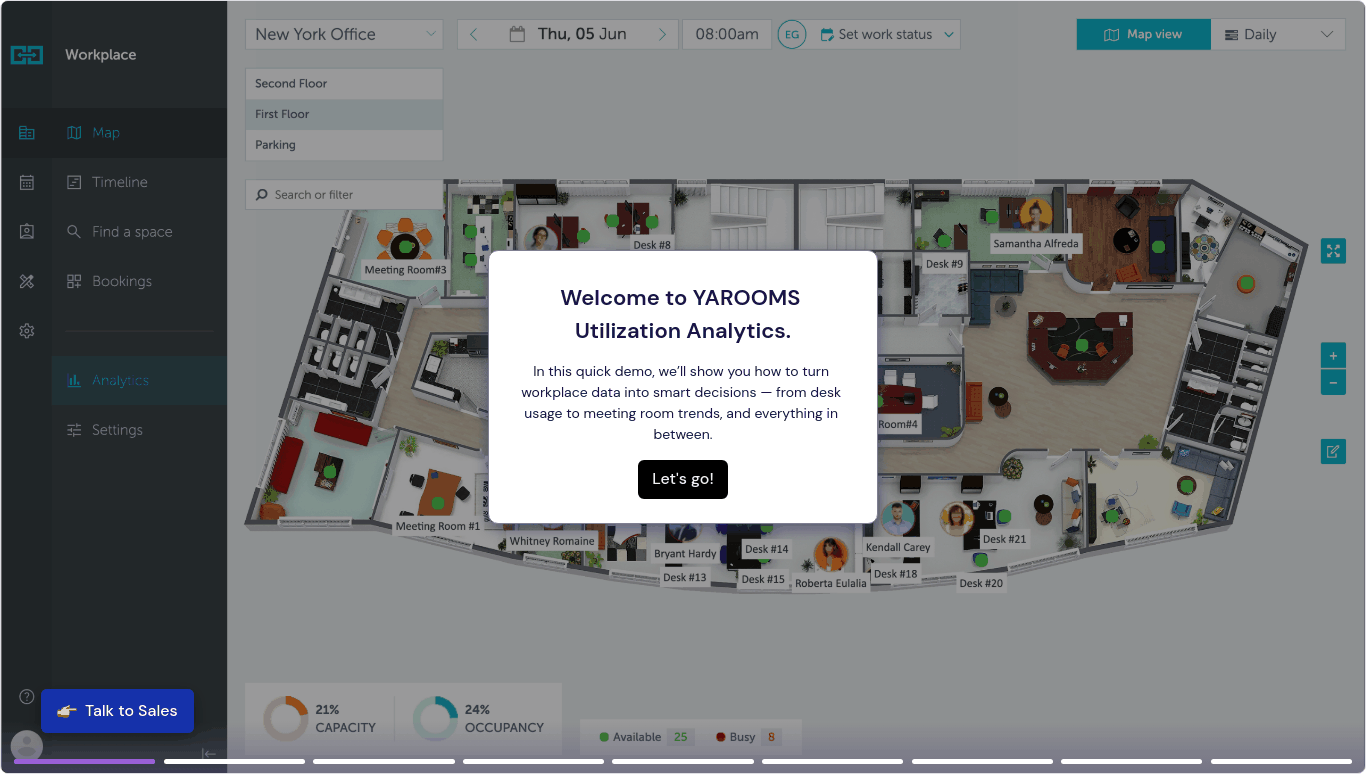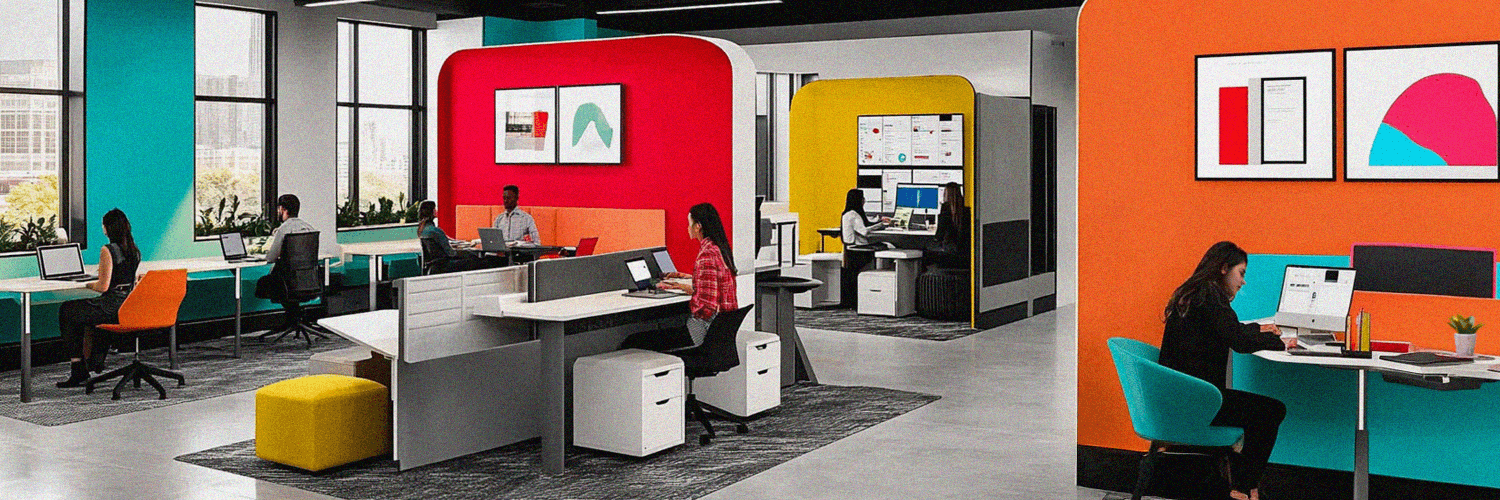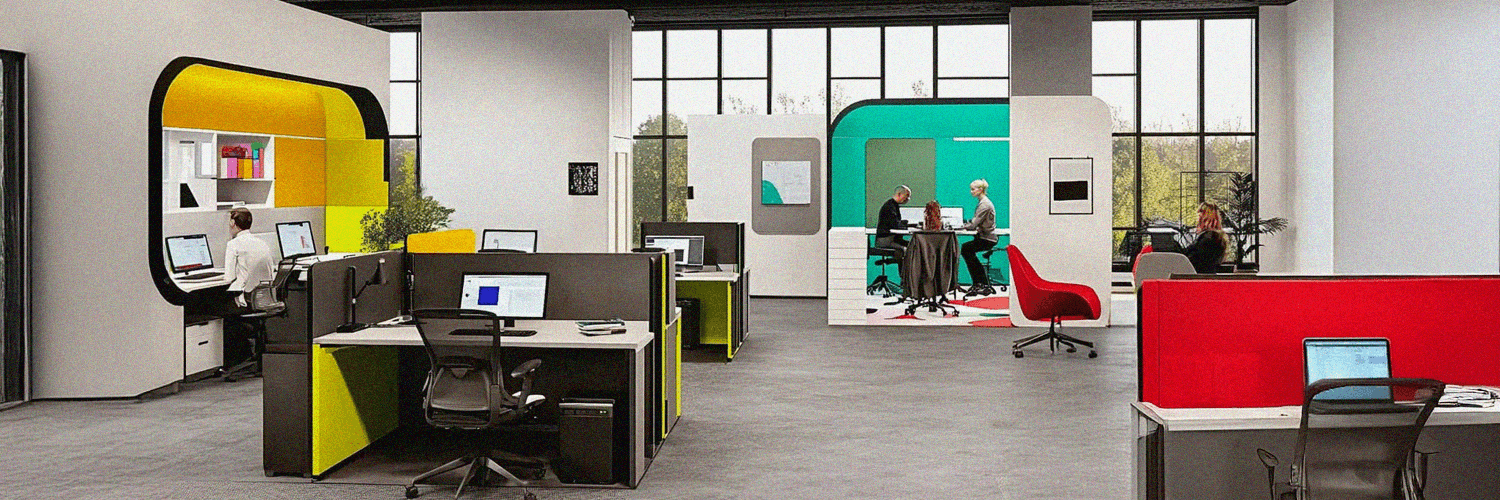[Updated 13 November, 2025]
Imagine starting your day in a workplace that actually energizes you - where ideas flow freely, collaboration feels effortless, and the environment supports both focus and well-being. While the perfect office might sound idealistic, real improvement is within reach.
In this guide, we’ll explore 20 practical ways to make your workplace better - from smarter collaboration habits to office design tweaks that lift engagement.
Each suggestion is rooted in research and many of them can be scaled with modern workplace management platforms like YAROOMS, helping you build an environment where people do their best work.
TL;DR: The article provides 20 data-driven strategies for comprehensive workplace improvement, focusing on six key dimensions: physical workspace design (e.g., flexible seating, biophilic elements), fostering collaboration (e.g., transparent communication, hybrid visibility), enhancing employee well-being, building an inclusive culture (e.g., ERGs, pay equity), recognition, and strategic technology integration (e.g., workplace management platforms, AI). Continuous improvement in these areas is crucial for boosting engagement, productivity, and retention in modern, often hybrid, environments.
Why Continuous Workplace Improvement Matters
Continuous workplace improvement is a necessity. It directly influences organizational success, employee satisfaction, and long-term performance. In fact, companies with continuous improvement culture are seven times more likely to have employees who innovate and deliver high performance.
Organizations constantly evolve through leadership changes, new technologies, hybrid work models, and responses to broader global challenges. Each transition brings new dynamics that demand adjustment. That’s why workplace improvement should be seen not as a one-time initiative, but as an ongoing process of adaptation, learning, and refinement.
Equally important is maintaining high employee morale, which directly shapes engagement, retention, and productivity. Gallup found that 41% of employees experience significant daily stress, while 44% leave their jobs due to poor work-life balance. These numbers underline a clear truth: when workplaces fail to evolve, people disengage and leave.
Ultimately, continuous improvement isn’t just about optimizing systems—it’s about creating an environment where people can thrive, adapt, and perform at their best.

Benefits of a Better Workplace Environment
A well-designed, supportive workplace environment makes people happier and drives measurable business outcomes.
Higher Employee Engagement and Productivity
A great work environment boosts motivation and focus. According to Steelcase research, employees who are highly satisfied with their physical and cultural environment show much higher engagement levels. Yet, 59% of workers are not engaged and 18% are actively disengaged - signaling a major opportunity for organizations to improve workplace conditions and unlock untapped productivity.
Takeaway: Investing in better workplace design and culture directly translates into higher performance and engagement.
Greater Innovation and Creativity
A positive work atmosphere encourages open collaboration and creative problem-solving. ADP study shows that employees who feel like genuine members of a team are more than twice as likely to be fully engaged, fueling innovation and new ideas. When people feel valued and included, they’re far more willing to take initiative and contribute to continuous improvement.
Takeaway: Belonging and trust spark innovation - and both start with a healthy workplace culture.
Lower Turnover and Stronger Talent Attraction
Improving the workplace has a direct impact on retention and recruitment. A Gartner survey of 1,300 employees found that only 33% believe their organizations deliver on promises related to their Employee Value Proposition (EVP). Companies that close this gap through workplace improvements can reduce turnover intentions by up to 56%, saving significantly on hiring and training costs.
Takeaway: A fulfilling workplace helps retain top talent and attracts new candidates who value trust and stability.
Stronger Company Reputation
A workplace that visibly prioritizes employee well-being reflects an organization’s values and credibility. It strengthens brand reputation among current employees, customers, and future recruits - positioning the company as an employer of choice in competitive markets.
Takeaway: When you care for people, your reputation grows with them.
How to Make Your Workplace Better: A Framework
To make your workplace better, you have to start building a sustainable framework that supports people and performance in equal measure. Meaningful improvement comes from focusing on six key dimensions, each contributing to a stronger, more adaptive organization:
Physical Workspace Design
Create environments that support different work styles and activities - from quiet focus zones to collaborative spaces. A well-designed workplace promotes comfort, concentration, and spontaneous interaction.
Collaboration and Communication
Encourage teamwork by making it easy for employees to connect, whether they’re in the office or remote. Clear communication channels, shared goals, and transparent processes strengthen alignment and trust.
Employee Well-being and Engagement
Support holistic employee health through flexible schedules, mental health resources, and wellness programs. Engaged employees feel valued, stay longer, and contribute more effectively.
Diversity, Equity, and Inclusion (DEI)
Build a workplace where everyone feels valued, heard, and empowered to contribute fully. Inclusive policies and equitable opportunities drive innovation and fairness across teams.
Recognition and Appreciation
Celebrate achievements - big or small. Regular feedback, peer recognition, and gratitude programs foster motivation and reinforce a positive workplace culture.
Technology Integration
Use modern workplace tools to simplify collaboration, streamline workflows, and enhance the employee experience. From booking systems to analytics dashboards, the right technology removes friction and empowers productivity.
20 Workplace Improvement Strategies
Take these ideas as inspiration and start building a better workplace in 2026.
| Area | Strategy | Core Idea |
|---|---|---|
| Physical Workspace | 1. Flexible Seating Arrangements | Replace fixed seating with hot desking/ activity-based setups to optimize space and autonomy. |
| 2. Use Workplace Analytics | Use utilization data to design zones that match actual work patterns. | |
| 3. Frictionless Space Technology | Implement booking systems & interactive maps for seamless space use. | |
| 4. Improve Lighting & Biophilic Design | Maximize natural light and nature elements to boost wellbeing and productivity. | |
| 5. Enhance Acoustic Comfort | Use quiet zones, sound absorption, and booths to reduce noise distractions. | |
| Collaboration & Communication | 6. Transparent Communication Policies | Promote open dialogue through Q&As, safe channels, and shared metrics. |
| 7. Diverse Collaboration Environments | Provide brainstorming rooms, project rooms, casual spaces, and hybrid hubs. | |
| 8. Hybrid Work Visibility | Use shared calendars & maps so employees know who’s on-site and when. | |
| 9. Structured Hybrid Team Building | Run inclusive activities for both remote and in-office teams. | |
| 10. Measure Collaboration | Track metrics (task rate, process time, touchpoints, feedback quality) to improve teamwork. | |
| Employee Well-being & Engagement | 11. Mental Health–Centered Spaces | Provide quiet rooms, ergonomic setups, outdoor access, and mindfulness areas. |
| 12. Innovative Benefits Programs | Offer flexible work, mental health support, caregiver programs, and financial well-being tools. | |
| 13. Professional Development Pathways | Create structured growth plans, mentorship, and learning budgets. | |
| 14. Comprehensive Wellness Programs | Offer holistic wellness (fitness, nutrition, stress management, sleep, social). | |
| DEI & Belonging | 15. Employee Resource Groups (ERGs) | Build structured, supported communities that drive belonging and innovation. |
| 16. Inclusive Leadership Development | Train leaders on bias, cultural competence, psychological safety, and accountability. | |
| 17. Pay Equity Frameworks | Audit compensation, use transparent pay bands, and track equity progress. | |
| 18. Accessible Workspaces | Apply universal design, WCAG standards, and accessibility audits. | |
| Recognition & Autonomy | 19. Multi-Dimensional Recognition Systems | Combine formal programs, peer recognition, public praise, and personalized appreciation. |
| 20. Increase Employee Autonomy | Enable flexibility, decision-making authority, outcomes-based evaluation, and self-directed development. |
20 workplace improvement strategies: quick reference cheat sheet
Creating a Productive Physical Workspace
A study by Fidson Healthcare found a very strong positive correlation (86.3%) between the comfort of workplace furniture and overall job satisfaction, showing that comfortable, well-designed environments directly influence employee happiness and productivity.
The physical workspace plays a crucial role in shaping how people think, collaborate, and perform. Thoughtful design helps employees stay focused, work creatively, and feel more connected to the organization.
Strategy #1: Design Flexible Seating Arrangements Based on Work Patterns
The approach: Adopt flexible seating models such as hot desking or desk hoteling, which allow employees to choose where and how they work. This approach not only supports different work styles but also optimizes real estate use by eliminating unused desks and rooms.
Why it matters: Traditional fixed seating arrangements rarely fit the diverse needs of modern teams. Many employees alternate between focused work, collaboration, and meetings - and static desk assignments can limit efficiency. Our own data shows that assigned desks remain vacant up to 50–60% of the workday, leading to wasted space and higher operational costs.
Real-world example: When ASEE Romania transitioned to a hybrid work model using YAROOMS, the company dramatically improved efficiency and reduced overhead. Employees could independently book desks, rooms, and on-site workdays, cutting down on coordination time and boosting satisfaction. The move also generated €200,000 in annual savings by downsizing office space - freeing up an entire floor while maintaining productivity.
How to implement:
-
Provide a mix of workspace types: focus pods, huddle rooms, collaboration zones, and casual seating areas.
-
Use desk booking software to manage availability and ensure fair access for all employees.
-
Establish clear guidelines on shared space etiquette, cleanliness, and booking priorities.
Takeaway: Flexible workspace design is one of the simplest, most cost-effective ways to support hybrid work and continuous workplace improvement.
Click to see the YAROOMS desk booking system in action
Strategy #2: Use Space Utilization and Booking Data to Create Activity-Based Work Zones
The approach: Data-driven space planning eliminates guesswork in workplace design. By leveraging office utilization data through platforms like YAROOMS, which offers comprehensive workplace analytics, organizations can make informed, evidence-based decisions about how to allocate and optimize space.
These analytics reveal how spaces are actually used (not how planners assume they’re used) enabling teams to create activity-based zones that reflect real work habits. For example, data might show that certain meeting rooms are consistently underbooked while others are always in demand, signaling a need to reconfigure layouts or adjust booking policies.
Why it matters: Data-backed workplace planning helps organizations design environments that genuinely support how people work. It improves space efficiency, enhances employee comfort, and prevents unnecessary real estate costs, ensuring every square meter contributes to productivity and engagement.
Case study: With the help of YAROOMS workplace analytics, a financial sector company discovered that 40% of their meeting rooms were regularly booked but typically used by only two or three people. Instead of expanding their office space, they reconfigured several large rooms into smaller collaboration areas. This simple change boosted effective meeting capacity without increasing their footprint, resulting in better space utilization and user satisfaction.
Key metrics to analyze:
-
Desk occupancy rates by time and day
-
Meeting room utilization and average group size
-
Dwell time in collaborative vs. individual zones
-
Peak usage patterns and potential bottlenecks
Click to see YAROOMS workplace analytics in action
Strategy #3: Implement Booking Technology for Frictionless Space Interactions
The approach: Workplace friction - those small daily frustrations that slow people down - often arises from difficulty finding and using office spaces effectively. Implementing desk and meeting room booking systems integrated with interactive office maps eliminates these obstacles and creates a seamless, intuitive workplace experience.
With the right tools in place, employees can:
-
Instantly locate available workspaces that fit their needs
-
Reserve desks and meeting rooms in advance or on demand
-
Find colleagues and teams for easier collaboration
-
Navigate unfamiliar office layouts with confidence
Why it matters: Frictionless space interaction enhances both efficiency and satisfaction. When employees can move through the office effortlessly, meetings start on time, collaboration flows naturally, and frustration drops. The result is a smoother workday, a more connected workforce, and an office environment that truly supports productivity.
Platforms like YAROOMS make these interactions simple by combining real-time availability, booking management, and map navigation in one interface - reducing time wasted searching for space and helping teams focus on meaningful work.
Strategy #4: Optimize Natural Lighting and Biophilic Elements
The approach: Lighting and environmental design play a powerful role in shaping how employees feel and perform. Natural light exposure in the workplace has been proven to enhance both well-being and productivity. Research found that employees working in well-lit environments reported 51% fewer eyestrain complaints, 63% fewer headaches, and up to a 15% increase in productivity.
Beyond lighting, biophilic design - connecting people with nature through plants, natural materials, and organic patterns - further enriches the work experience. According to Human Spaces research, offices that incorporate biophilic elements see productivity rise by 8% and well-being improve by 13%.
Why it matters: A workplace that embraces natural light and biophilic design not only looks better but also supports healthier, happier, and more productive employees. It demonstrates a tangible investment in wellbeing - one that pays off through improved focus, reduced fatigue, and a stronger sense of connection to the workspace.
How to implement:
-
Arrange workstations to maximize access to windows and natural light
-
Use glass partitions instead of solid walls to allow light flow
-
Install smart lighting systems that adapt to daylight levels
-
Introduce indoor plants, living walls, and natural materials throughout the space
Strategy #5: Enhance Acoustic Comfort for Focused Work
The approach: Noise is one of the most common (and underestimated) sources of frustration in the workplace. According to Acoustic Bulletin, an overwhelming 99% of employees say their concentration is disrupted by office noise, particularly background conversations and phones ringing at empty desks. A thoughtful acoustic design strategy can drastically reduce these distractions, helping employees stay focused and calm throughout the day.
Why it matters: Reducing unwanted noise isn’t just about comfort - it’s about performance. A quieter, acoustically balanced workplace helps employees think clearly, concentrate longer, and experience less stress. Studies show that reducing noise distractions can increase the ability to focus by nearly 50% and improve cognitive performance, leading to fewer errors and higher productivity.
How to implement:
-
Create designated quiet zones for deep, focused work
-
Use sound-absorbing materials (like acoustic panels, carpets, or ceiling tiles) in high-traffic areas
-
Install white noise systems to mask distracting sounds and balance ambient noise levels
-
Add acoustic phone booths or small enclosed pods for private calls and meetings
Fostering Collaboration and Communication
86% of employees and executives cite a lack of effective collaboration and communication as the primary cause of workplace failures. A workplace that encourages open communication, shared goals, and easy knowledge exchange doesn’t just prevent breakdowns - it fuels creativity, strengthens relationships, and drives better business outcomes.
Strategy #6: Establish Transparent Communication Policies
The approach: Transparency is the foundation of organizational trust. When leaders communicate openly and employees feel safe to share feedback or concerns, engagement and collaboration naturally improve. An open-door policy - whether literal or cultural - empowers team members to express ideas, ask questions, and seek guidance without hesitation.
Why it matters: Transparent communication fosters accountability, reduces misinformation, and builds mutual respect between leaders and employees. Over time, this openness strengthens workplace culture, increases retention, and drives engagement across all levels of the organization.
Example: Briggs Industrial Solutions implemented several transparency-focused strategies between 2022 and 2023, including profit sharing and clear career paths for technicians. The results were striking: a 17-point increase in perceptions of employee recognition and a 14-point improvement in perceptions of fair pay — both of which dramatically boosted the company’s ability to attract and retain talent.
How to implement:
-
Host regular leadership Q&A sessions where no topic is off-limits
-
Create clear and safe communication channels for raising concerns
-
Share organizational performance metrics and challenges consistently
-
Involve employees in decision-making processes through surveys or working groups
Strategy #7: Create Diverse Collaboration Environments
The approach: Not all collaboration looks the same - and it shouldn’t happen in the same kind of space. Different types of teamwork require distinct environments that support creativity, focus, and connection. By designing a variety of collaboration zones, organizations can accommodate brainstorming, project work, casual exchanges, and hybrid meetings more effectively.
Why it matters: Providing multiple collaboration settings ensures every team - whether creative, technical, or cross-functional - has the right environment to thrive. It reduces friction, encourages inclusivity, and helps ideas move from discussion to execution faster. In a hybrid world, space diversity = collaboration flexibility.
Spaces to consider:
-
Brainstorming zones with writable walls, movable furniture, and digital capture tools to turn ideas into action.
-
Project rooms where teams can leave materials and visuals up between sessions, preserving momentum.
-
Casual collision spaces — lounges, café-style areas, or shared walkways — that encourage spontaneous conversation and idea-sharing.
-
Digital collaboration hubs equipped with video conferencing, interactive displays, and tools that make hybrid teamwork seamless.
Strategy #8: Implement Hybrid Work Visibility Solutions
The approach: In hybrid workplaces, one of the biggest collaboration challenges is not knowing who will be in the office and when. Without visibility into colleagues’ schedules, opportunities for teamwork and spontaneous interaction are easily lost. Implementing hybrid work visibility solutions - such as shared calendars and interactive office maps - helps teams plan on-site collaboration more intentionally and maintain strong connections across work modes.
A Stanford University study highlights the importance of transparency in hybrid work. In a randomized controlled trial at Trip.com involving 1,612 employees, providing visibility into colleagues’ work arrangements led to a 33% reduction in resignations, higher job satisfaction, and no negative impact on performance — proving that openness supports both retention and productivity.
Why it matters: When employees know where and when to find their colleagues, teamwork feels natural again, even across distributed teams. The right visibility tools bring clarity, connection, and coordination back into hybrid work.
Success story: After adopting YAROOMS’ hybrid work scheduling calendar, a global tech firm saw a 26% increase in cross-team collaboration. Employees could easily see who would be on-site each day, allowing them to schedule brainstorming sessions, quick problem-solving meetings, and team syncs more effectively. The result was faster communication, more coordinated project work, and a stronger sense of connection between teams.
Click on the media to discover YAROOMS hybrid work calendar
Strategy #9: Organize Hybrid Team Building Activities
The approach: Building strong, connected teams becomes more challenging - and more essential - in hybrid environments. Because employees are distributed across locations and schedules, team cohesion doesn’t develop naturally. Structured hybrid team building activities help bridge this gap by creating meaningful, shared experiences for both remote and in-office employees.
Why this matters:
Research from Gallup shows why this is important:
-
37% of fully remote employees are engaged
-
33% of hybrid employees are engaged
-
27% of on-site employees are engaged
These numbers reveal that engagement varies across work arrangements — and that intentional effort is required to maintain strong, connected teams regardless of where people work.
How to implement:
-
Host virtual and in-person workshops designed so everyone participates equally
-
Run team challenges that pair remote and on-site employees
-
Schedule informal virtual gatherings focused on non-work conversations
-
Hold recognition events that celebrate achievements across all work modes
Strategy #10: Measure Collaboration to Improve It
The approach: Organizations can’t improve collaboration if they never measure it. Tracking collaboration metrics provides a clear view of how well teams work together, where breakdowns occur, and which processes need refinement. By treating collaboration as something measurable organizations can continuously strengthen teamwork and alignment.
Why it matters: Teams that track collaboration report 47% better alignment on priorities and 34% faster decision-making compared to teams without measurement systems. In other words, what gets measured gets improved. Collaboration becomes clearer, smoother, and more intentional when organizations use data to guide team behavior and workflow design.
How to implement:
Use specific, actionable metrics to assess collaboration quality, such as:
-
Task completion rate: Percentage of collaborative tasks completed versus assigned
-
Average process time: How long cross-functional workflows take from start to finish
-
Number of touchpoints: How many handoffs occur between team members (a signal of workflow efficiency or complexity)
-
Feedback effectiveness: How well teams give and receive constructive input, measured through surveys or peer reviews
These metrics create a factual baseline for improvement and help teams understand which behaviors or processes need to change.
Enhancing Employee Well-being and Engagement
Employee well-being is a powerful driver of productivity, creativity, and long-term retention - yet global well-being remains low. In 2025, only 35% of employees worldwide described themselves as thriving in their overall well-being, highlighting a critical opportunity for organizations to do better.
The following strategies focus on creating a workplace that supports holistic employee health, strengthens engagement, and helps people feel energized and supported in their day-to-day work.
Strategy #11: Design Spaces for Mental Health and Well-being
The approach: Workplace design has a direct influence on mental health. Environments that reduce stress and support emotional balance help employees think clearly, regulate energy, and stay engaged throughout the day. Creating spaces intentionally dedicated to psychological well-being can improve cognitive function and overall workplace satisfaction.
Why it matters: A workplace that prioritizes mental health fosters stronger focus, improved emotional resilience, and higher engagement. When employees feel balanced and supported, they show up with more creativity, clarity, and motivation - elevating both individual and organizational performance.
How to implement:
Incorporate elements that actively support mental restoration and comfort, such as:
-
Quiet retreat areas where employees can decompress during the workday
-
Outdoor access or biophilic design features (plants, natural textures) to lower stress levels
-
Ergonomic workstations that reduce physical strain and contribute to mental ease
-
Dedicated spaces for mindfulness, meditation, or short mental breaks
-
Natural ventilation and air quality monitoring to promote alertness and reduce fatigue
Strategy #12: Develop Innovative Employee Benefits Programs
The approach:
Employee needs have evolved beyond traditional benefits. Today’s workforce expects support that reflects the full spectrum of their well-being - from mental health to financial security to family responsibilities. Forward-thinking organizations design holistic benefits programs that meet employees where they are and help them thrive both at work and in their personal lives.
Why it matters:
Comprehensive benefits directly improve performance. Organizations with robust well-being programs see a 41% reduction in absenteeism and a 21% increase in productivity. Benefits that support the whole person help create healthier, more committed, and more resilient employees.
How to implement:
Consider expanding your benefits offering with programs such as:
-
Flexible working arrangements that adapt to personal needs and preferences
-
Mental health support, including therapy access, counseling, or stress management resources
-
Caregiver support programs for employees balancing work and family responsibilities
-
Financial well-being initiatives, such as financial education or planning sessions
-
Sabbatical programs to help long-term employees recharge and prevent burnout
Strategy #13: Create Professional Development Pathways
The approach: Career stagnation is one of the fastest ways to erode employee satisfaction and increase turnover. Implementing structured professional development pathways signals to employees that the organization is invested in their growth - while simultaneously strengthening internal capabilities and preparing teams for the future.
Research from Gartner shows the urgency: only 46% of employees feel supported in growing their careers at their current organization. This represents a major gap — and a major opportunity for forward-thinking companies.
Why it matters: When employees see a clear future in the organization - and feel supported in reaching it - they’re more engaged, motivated, and loyal. Development pathways transform career growth from a personal challenge into a shared organizational priority.
How to implement:
-
Create individual development plans with transparent advancement criteria
-
Offer tuition reimbursement or stipends for continued education
-
Establish internal mentorship programs pairing junior and senior employees
-
Run skills development workshops aligned with future organizational needs
-
Encourage cross-functional project participation to broaden experience and build versatility
Implementation example: A rapidly growing tech startup introduced individualized development plans linked to quarterly objectives. Every employee received a personal learning budget and dedicated time for upskilling. Within six months, the company saw a 31% increase in career satisfaction and a 24% drop in voluntary turnover, proving that development pathways deliver tangible cultural and retention benefits.

Strategy #14: Implement Comprehensive Wellness Programs
The approach: Employee well-being is multidimensional - spanning physical health, mental resilience, social connection, and lifestyle habits. Comprehensive wellness programs address all of these areas, helping employees feel supported both inside and outside of work. Holistic initiatives create healthier teams, reduce burnout, and foster stronger community across the organization.
Why it matters: Wellness initiatives pay off. An analysis in the Journal of Occupational Health found that organizations with well-designed wellness programs see healthcare cost reductions of $3.27 for every dollar invested, and absenteeism cost reductions of $2.73 per dollar spent. Comprehensive programs not only boost employee health and morale but also deliver meaningful financial returns.
How to implement:
Build a program that offers diverse participation options, such as:
-
Fitness facilities or subsidized gym memberships
-
Nutrition education sessions and healthier food choices
-
Stress management and resilience training
-
Sleep improvement programs
-
Social connection activities, volunteer days, or community service events
To maximize the effectiveness of these programs, ensure they are:
-
Accessible to all employees, including remote and deskless workers
-
Customizable to personal needs and preferences
-
Measured using both participation data and well-being outcomes
-
Evolving continuously based on employee feedback and usage patterns
Building an Inclusive and Diverse Workplace
Diversity, equity, and inclusion are critical drivers of workplace performance, belonging, and long-term talent retention. Today, 66% of employees say they notice DEI efforts in their workplace, and 80% want to work for companies that actively value DEI. This makes DEI not only a moral imperative but also a strategic one, shaping employer reputation, engagement, and workforce stability.
Effective DEI initiatives create environments where people of all backgrounds feel respected, supported, and able to contribute their best work. The following strategies outline practical ways organizations can strengthen DEI and build workplaces where everyone can thrive.
Strategy #15: Establish Effective Employee Resource Groups
The approach: Employee Resource Groups (ERGs) play a powerful role in strengthening engagement, retention, and workplace belonging. By offering community, support, and advocacy for various employee populations, ERGs help organizations create more inclusive and connected environments. Companies that invest in well-structured ERGs often see:
-
Higher retention rates, especially among underrepresented groups
-
Increased innovation through diverse viewpoints
-
Stronger talent acquisition driven by authentic employer branding
-
A more unified and supportive company culture
Why it matters: A BCG study found that organizations with above-average management diversity reported 19 percentage points higher innovation revenue than those with below-average diversity. Another BCG report on Finland showed that companies with diverse leadership teams achieved EBIT margins nine percentage points higher than less diverse peers.
How to implement:
Build ERGs with structure, support, and clarity by ensuring:
-
Clear mission statements and goals aligned with organizational priorities
-
Executive sponsorship and visible leadership support
-
A dedicated budget and resources to run meaningful programs
-
Regular measurement of outcomes and organizational impact
-
Recognition of ERG participation in performance reviews to reinforce its value
Strategy #16: Implement Inclusive Leadership Development
The approach: Inclusive leadership is becoming a core competency for modern organizations. By embedding DEIB (diversity, equity, inclusion, and belonging) skills into leadership development programs, companies ensure that managers at every level are equipped to build equitable, high-performing teams. Leaders are increasingly held accountable for fostering inclusive cultures — a shift that strengthens engagement, trust, and collaboration across demographic groups.
Organizations that invest in inclusive leadership see measurable benefits, including:
-
Higher employee retention across diverse populations
-
Increased psychological safety and team-level innovation
-
Stronger cross-cultural communication and collaboration
-
Better decision-making informed by diverse viewpoints
Why it matters: A McKinsey study found that companies in the top quartile for leadership diversity are 36% more likely to outperform industry peers on profitability, underscoring the direct business value of diverse, inclusive leadership.
How to implement:
Build inclusive leadership into your development programs with:
-
Unconscious bias training to help leaders identify and mitigate blind spots
-
Cultural competence development, especially for global or cross-functional leadership
-
Coaching on psychological safety, empowering leaders to support diverse team members
-
Accountability metrics tied to inclusion outcomes, reviewed regularly alongside performance goals
Strategy #17: Develop Pay Equity Frameworks
The approach: Pay equity is a cornerstone of an inclusive, trusted workplace. Organizations that build global pay equity frameworks consistently close pay gaps, strengthen fairness, and boost employee satisfaction. A structured approach ensures compensation decisions are transparent, data-driven, and free from bias, supporting both equity and retention.
How to implement:
To create a robust pay equity framework, organizations should:
-
Conduct regular compensation audits across all demographic groups
-
Establish transparent pay bands and promotion criteria
-
Implement processes that reduce negotiation-related disadvantages, such as standardized starting salaries or defined raise guidelines
-
Train managers on equitable compensation practices and bias-free decision-making
-
Measure and report on pay equity progress consistently to maintain accountability
Real-life example: Holcim Europe successfully aligned compensation strategies across multiple countries by integrating pay audits, benchmarking external market pay, and analyzing internal equity. This led to improved retention insights, fairer pay decisions during hiring and transfers, and better cost control. Their success also stemmed from transparent communication and manager training as part of the framework rollout
Strategy #18: Create Accessible Digital and Physical Workspaces
The approach: Accessibility is essential for creating a workplace where every employee can fully participate and succeed, regardless of physical, sensory, or cognitive abilities. Building accessibility into both physical environments and digital tools ensures equitable experiences across all roles and locations. It also strengthens organizational culture by removing barriers that can limit performance, inclusion, and belonging.
Why it matters: Organizations that prioritize accessibility benefit from expanded talent pools, richer innovation powered by diverse perspectives, and stronger brand reputation among employees and customers alike. Accessibility isn’t just a legal requirement — it’s a strategic advantage that helps everyone contribute their best work.
How to implement:
A comprehensive accessibility strategy should include:
-
Universal design principles in physical workspaces (ramps, adjustable desks, clear pathways)
-
WCAG-compliant digital tools and platforms to support screen readers, keyboard navigation, and visual clarity
-
Inclusive meeting protocols, such as captioning, clear agendas, and accessible materials
-
Flexible work arrangements that accommodate different ability requirements
-
Regular accessibility audits of spaces and systems, paired with actionable improvement plans
Recognizing and Appreciating Employees
Recognition is one of the most powerful drivers of engagement. Well-designed recognition programs have been shown to increase employee engagement by 12–20% within the first 6–12 months, directly contributing to higher job satisfaction, motivation, and morale. When people feel seen and valued for their contributions, they show up with more energy, better performance, and a deeper sense of loyalty to the organization.
Strategy #19: Develop Multi-Dimensional Recognition Systems
The approach: Recognition is most effective when it reflects the full range of employee contributions - not just major milestones but also everyday actions that reinforce culture and drive progress. Multi-dimensional recognition systems acknowledge both formal achievements and informal successes, helping employees feel seen, valued, and connected to organizational purpose.
Why it matters:
Research from Gallup and Workhuman shows that well-recognized employees are 45% less likely to leave their jobs and demonstrate significantly higher engagement. Conversely, employees who feel under-recognized are twice as likely to say they’ll quit within the next year. Recognition isn’t just a morale boost — it’s a critical driver of retention, performance, and long-term workplace satisfaction.
How to implement:
Build a recognition system that blends multiple formats, such as:
-
Structured recognition programs tied directly to company values and key behaviors
-
Peer-to-peer recognition platforms that enable real-time appreciation
-
Public acknowledgment in team meetings, town halls, or internal communications
-
Personalized recognition tailored to individual preferences and motivations
-
Celebration of both outcomes and positive behaviors, not just results
Strategy #20: Increase Employee Autonomy
The approach: Employee autonomy is one of the strongest predictors of engagement, innovation, and job satisfaction. When people have control over how they work - not just what they work on - they feel more trusted, motivated, and empowered to deliver their best. Autonomy signals confidence in employees’ abilities and creates the conditions for creativity, problem-solving, and personal ownership.
Why it matters: When employees are given room to make decisions, manage their work, and grow on their own terms, engagement and innovation rise naturally. Autonomy helps cultivate a high-trust, high-performance culture where people feel respected and motivated to exceed expectations.
How to implement:
Enhance autonomy through practical policies and practices such as:
-
Flexible work arrangements around schedule and location
-
Results-focused performance metrics that measure outcomes, not activity or time spent
-
Decision-making authority aligned with each role’s expertise and responsibilities
-
Opportunities to contribute input on team goals, plans, and processes
-
Self-directed learning resources employees can use to grow their skills independently
Workplace Improvement Trends for 2026
As organizations look ahead, several workplace trends are set to redefine how people collaborate, grow, and experience work in 2026. These shifts reflect broader changes in technology, employee expectations, and global business dynamics.
AI Integration and Adaptation
AI adoption is accelerating at unprecedented speed. 96% of employers plan to integrate generative AI into their workflows, yet a gap remains between leadership expectations and employee perceptions. McKinsey research shows employees are three times more likely than leaders to believe that AI will replace 30% of their work within a year.
To navigate this shift successfully, organizations must:
-
Prioritize upskilling and reskilling to build confidence and capability
-
Develop AI “super teams” that combine human judgment with AI-driven efficiency
-
Establish clear AI implementation frameworks
-
Create ethical guidelines around transparency, data use, and oversight
-
Train employees on effective human-AI collaboration
For 2026, AI readiness will be a competitive advantage - not just technologically but culturally.
Hybrid Work Optimization
Hybrid work is now the dominant model. According to CBRE, 92% of companies use some form of hybrid work. But with adoption no longer the challenge, the focus has shifted to refinement and optimization.
Key areas of focus include:
-
Creating seamless collaboration between remote and on-site teams
-
Reimagining offices as social, collaborative hubs
-
Designing equitable hybrid work policies that avoid location bias
-
Using workplace analytics to fine-tune schedules and space utilization
As hybrid work matures, organizations are moving beyond logistics to strategies that maximize both flexibility and cohesion.
Employee Well-being and Mental Health
Employee well-being remains a central priority. 41% of employees experience significant daily stress, according to Gallup, prompting organizations to treat health as a strategic, not supplemental, investment.
Leading companies are:
-
Expanding mental health support systems
-
Designing holistic wellness programs (physical + psychological)
-
Introducing policies that prevent burnout and improve work-life balance
-
Training managers to identify and support mental health challenges
-
Integrating well-being metrics into leadership scorecards and performance dashboards
In 2026, well-being becomes a measurable business outcome - not just an HR initiative.

Skills-based Talent Strategies
Skills gaps continue to widen, driving a shift toward skills-based hiring, development, and workforce planning. According to Robert Half’s research, companies are prioritizing:
-
Upskilling existing staff (52%)
-
Reskilling employees for new roles (47%)
-
Supporting professional certifications (45%)
-
Hiring contract professionals with targeted expertise (40%)
A notable emerging trend is the rise of “new-collar” jobs — roles requiring advanced technical skills but not necessarily four-year degrees. This broadens the talent pool, promotes diversity, and helps organizations fill critical roles more efficiently.
Measuring Workplace Improvement Success
Use these core metrics to measure whether your workplace improvement efforts are delivering meaningful, measurable results.
| Category | Key Metrics | What They Reveal |
|---|---|---|
| Physical Workspace |
- Occupancy Rate - Peak Usage Times - Density - Immediate Occupancy Rate - Meeting Room Utilization |
How efficiently space is used and where bottlenecks or underutilization exist. |
| Collaboration Effectiveness |
- Task Completion Rate - Average Process Time - Number of Touchpoints - Feedback & Collaboration Quality |
How well teams coordinate, communicate, and deliver cross-functional work. |
| Employee Well-being |
- Engagement Score - Retention Rate - Employee Net Promoter Score (eNPS) - Well-being Index - Absenteeism Rate |
Employee health, satisfaction, loyalty, and overall workplace morale. |
| Diversity & Inclusion |
- Demographic Representation - Promotion Equity - Pay Equity - Inclusion Survey Results - ERG Participation & Impact |
Fairness, representation, belonging, and inclusivity across the organization. |
Measuring workplace improvement success: metrics overview
Mistakes That Slow Down Workplace Improvement
Workplace improvement efforts can lose momentum when organizations fall into avoidable mistakes. Here are the most common pitfalls to watch for.
Ignoring Employee Feedback
Workplace changes implemented without employee input often miss the mark. When leaders rely on assumptions instead of insights, improvements may solve the wrong problems — or create new ones. Effective feedback loops should include:
-
Pulse surveys to gauge real-time workplace satisfaction
-
Focus groups to explore specific challenges in depth
-
Open forums for employees to share suggestions
-
Post-implementation reviews to evaluate what worked and what didn’t
Improvement succeeds when employees feel heard and included.
Micromanagement Over Autonomy
Excessive control slows progress, discourages initiative, and signals mistrust. Micromanagement often shows up as:
-
Required approval for routine decisions
-
Excessive documentation of minor tasks
-
Frequent check-ins without clear purpose
-
Limited autonomy in how employees execute work
Autonomy boosts innovation, ownership, and engagement — while micromanagement does the opposite.
Communication Breakdowns
Poor communication creates confusion, resistance, and inconsistent execution. The most common failures include:
-
Failing to explain the “why” behind workplace changes
-
Inconsistent or conflicting messages from leaders
-
Limited channels for two-way communication
-
Not closing the feedback loop after collecting input
Clear, transparent communication keeps everyone aligned and reduces friction during change.
Disregarding Work-Life Balance
Organizations that push constant availability and maximum output often face predictable consequences:
-
Higher absenteeism and increased healthcare costs
-
Declines in productivity and creativity
-
Elevated turnover and loss of high performers
-
Damage to employer reputation and brand
Sustainable improvement requires respecting employee well-being, not overwhelming it.

It's Time to Take Action for a Better Workplace!
Workplace transformation doesn’t happen overnight - but meaningful change begins with intentional, incremental steps. Here’s how to turn your goals into lasting impact:
-
Evaluate your current environment: Use employee surveys, space utilization data, and performance metrics to identify your biggest opportunities for improvement.
-
Engage your workforce: Involve employees at all levels through feedback channels, design workshops, and pilot programs to ensure solutions truly meet their needs.
-
Develop a phased implementation plan: Build a clear roadmap that tackles immediate pain points while laying the foundation for long-term improvements.
-
Measure and adjust: Establish baseline metrics, set realistic improvement targets, and revisit them regularly — refining your approach based on results and feedback.
-
Celebrate progress: Recognize milestones and highlight wins to maintain momentum and show employees that their workplace is continuously evolving.
Workplace improvement is not a one-time initiative - it’s an ongoing journey that adapts to employee needs, technological capabilities, and organizational goals. Companies that embrace continuous enhancement not only attract and retain top talent, but also create environments where people perform at their best.
Don’t just imagine a better workplace - start improving yours today.














